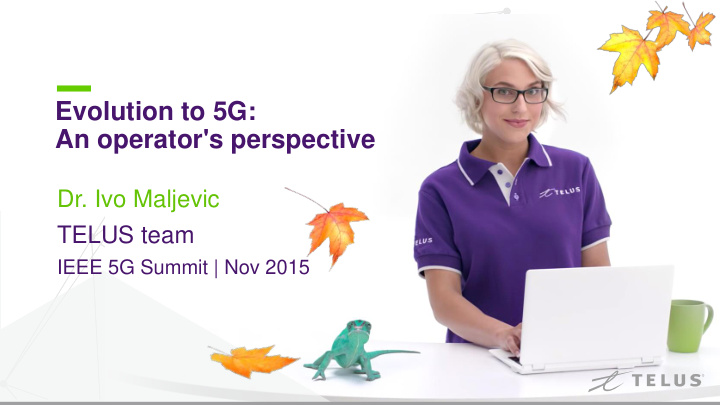



Evolution to 5G: An operator's perspective Dr. Ivo Maljevic TELUS team IEEE 5G Summit | Nov 2015
2 Cellular Standards Evolution ? 1980 – 1G 1990 – 2G 2000 – 3G 2010 - 4G 2020 – 5G • • • • • Analog systems Digital systems begin Emergence of smart Widespread adoption Global 5G standard phones of smartphones developed by 3GPP • • Large terminals Smaller Phones • • • Dominated by two Dominated by Massive connectivity • • Several systems Several systems standards: UMTS LTE/LTE-A standard • Data rates 1Gbps+ • • Voice only Lower power and CDMA2000 developed by 3GPP (fibre like speeds) consumption • • Data rates up to 42 Data rates 150+ Mbps • Very fast service • Low data rate Mbps • Rich services introduction services (SMS, email) • Wide range of services Economy of Scale through standardization
3 Why do we need 5G? Target Use Cases Enhanced Mobile Broadband Massive Machine Type Ultra-Reliable, Low-Latency (eMBB) Communications (mMTC) Communications (uMTC) 100+ Mbps avg. throughput 10 6 /km 2 connection density 99.999% service availability 10+ Gbps peak throughput Low cost/energy connectivity 1 – 10 ms latency Mobile video and gaming Billions of connected devices Tactile Internet Cloud computing and storage Sensor networks Natural disaster relief High speed connectivity IoT / M2M / D2D E-Medicine and Health care 5G will enable diverse services and use cases that cannot be fully addressed by 4G systems
4 Key Performance Differences Between 4G and 5G Targets Connection Spectrum Data rate Latency Mobility density efficiency 5G Target > 100 Mb/s (avg) As much as > 100,000 ~ 1 ms > 500km/h > 10,000 Mb/s possible (peak) Avg ~25 Mb/s 4G DL: 0.1 – 6.1 b/s/Hz Typically ~50 ms Functional Typically ~2,000 Peak 150 Mb/s UL: 0.1 – 4.3 b/s/Hz Active users/km 2 10 ms for 2-way RAN Up to 350km/h Target 5G network capabilities often exceed 4G by a large margin
How do we get there?
6 RAN Evolution From Distributed to Virtualized BBU – RRU separation Centralization Virtualization RRU BBU RRUs BBU HW Accelerator Virtual Cell Server RRUs Central office Central office Distributed RAN (4G) Centralized RAN (4.5G) Virtualized RAN (5G) Seamless migration from 4G RAN to 5G RAN
7 Network Evolution Through SDN/NFV Different Platforms of Today • Internet traffic flows across different service platforms • Services operated on specialized Physical and Control infrastructure Converged, Cloud based Platform for 5G • Services that previously required dedicated hardware are abstracted into software functions • Services will be provisioned and controlled on common infrastructure • SDN/NFV will unify ALL SERVICES Fixed and Mobile Convergence
8 5G Service Delivery Today’s Network Service creation in 6+ months Service-specific EPC access Blanket HSS/HLR AAA IMS Service Non-3GPP Access SMSC Delivery Policy Server ePDG (eg: ANDSF, HS2.0) WAG MSS/MGW 3GPP Access Customers pick the Access either by device type, app design, or simple steering from network Data Center Automated Service creation in minutes 2020+ Network E2E Configuration Network Personalized Agnostic access Access Selection and Network Configuration Service Non-3GPP Delivery Access Wireline Network Home 3GPP Access Access Network The network is responsible for picking most efficient Access to deliver optimal service/user experience
9 3GPP and ITU Timelines 2016.3 2017.6 2018.9 2019.12 Rel- Rel-15 Rel-16 Rel-14 13 (Early 5G) (Full 5G) 5G SI(s): Scenario and Requirements… SI: HF (>6GHz) channel model Other features / Enhancements 5G SI(s): New RAT framework High frequency (>6GHz) specific feature design 5G phase 2 WI(s) 5G phase 1 WI(s) LTE-Advanced Pro Evolution (4.5G) WRC-19 WRC-15 Proposal Spec ITU process Initial 5G deployments anticipated by 2020
10 TELUS 5G Research (University Sponsorships) HetNets Traffic Models Massive MIMO + CoMP Optimal interference management and Traffic demand modeling in Coordinating transmissions resource allocation schemes using fractional time and space for between large numbers of cooperation. Also, new methods to analyze heterogeneous 5G networks; cells with large numbers of cellular networks with irregular deployment of backhaul and fronthaul antennas. cells with varying traffic over hot spots. requirements. Smart Application on Virtual 5G Waves RRM and Energy efficient design Infrastructure New wireless access Spectral and energy efficient design Cloud Computing in Data virtualization schemes, radio resource and interference centre, Software Defined architectures and management in multi-tier and multi- Networking and Virtualization. designs. RAT networks. Strong partnerships with major Canadian research institutes
Q&A THANK YOU
Recommend
More recommend